This is one of the most picturesque treks in the country; the irresistible landscape overwhelms even the locals – you will find many of them sitting over a rocky outcrop and admiring the view. Join them for a few memorable minutes, listen to their tales, share yours, take pictures. And continue with a spring in your step, happy having met some of the nicest folks on planet!
The Kuari Pass trek is also known as Lord Curzon’s trail, named after a viceroy of the Raj who was an avid trekker and adventurer. While Curzon began his trek from Ghat and passed via Ramni before reaching Joshimath, where renowned sage Shankaracharya attained Enlightenment and established his ashram, today we trace the trek in the reverse direction, starting from Auli which is near Joshimath. The trek begins with an invigorating climb over the cirque that forms the Auli ski centre which, at this time of the year (April – June) is a rustling ochre grassland merrily swaying to the brumal gusts rising from the snow-capped mountains. The weather is usually crisp and sunny – warranting a good SPF – and nippy under the shade. Then, as they say in these parts: “Anything can happen, up here the mountains haven’t heard of the Met dept.”
Top tip: Have a raincoat handy for sudden downpours during summer and sub-zero temperatures if you are visiting during winter.
A moderate trek which can be tried by first timers with average fitness levels, the Kuari trail throws up many spectacular sights of which the highlights are the sure sightings of at least half dozen 5000-footers like the Nanda Devi (7816 metres), Kamet (7757 metres), Chaukhamba (7128 metres), Trishul (7120 metres), the Dronagiri ((7066 metres) to name some. The campsites during the trek have been chosen carefully keeping in mind not just the basic requirements like water or access but also for their immense beauty. Gurgling rivulets, rhododendrons meandering like Algerian love knots, towering snow-clad peaks in the horizon, all make bivouacking at Tali and Khulara a trip of their own.
Day 1: Haridwar – Auli (2450 metres, 280 km, 12 hours)
The initial stretches of the ride from Haridwar is a bit unsettling as the roads usually give way to the inclement weather and heavy traffic prevalent in the region. Nevertheless it is not shorn of some very interesting sights – the choc-a-bloc rafting businesses flanking the road flaunting outlandish names, numerous temples and ashrams peeved at the cacophony, sometimes even a travelling local deity or a lost yogi. Dapper sardars roaring away on their loud, big bikes charged with newfound benedictions from the Hemkunt Sahib. During the drive, you will be tracing the Ganga and the Alaknanda Rivers. The confluence of the Alaknanda and the Bhagirathi at Devprayag can be seen from the road – a momentous, multi-hued embrace which adds to the township’s religious appeal. After these holy towns, the traffic clears considerably and the horizon gets tinted mint blue haloing the treeline and soon enough follows the irresistible beckoning of the snow-draped behemoths.
Day 2: Auli – Tali (3200 metres, 10 km)
An early start is advised for any trek – as it gives you enough time to enjoy the scenery on the way and helps you reach camp before it gets dark. The trek is officially underway from the Auli ski centre, which are the Auli ‘meadows’ at this time. Passing the meadows, you enter a forested area, a steep climb brings you up to a local shrine bedecked with flags; a heavy bell dispatches resounding, robust chimes through the verdant canopy painting shifty silhouettes on the forest floor. The wooded trail involves around a couple of hours’ weaving through chestnut trees, grandpa oaks, deodars and maple trees. And just when you are least expecting, it suddenly opens to the very pretty meadows of Gurson (which in local dialect means ‘cow herding’). Here you will come across shepherds with large flocks that spread over the landscape in black and yellow flecks. An isolated, nearly vertiginous path etched around the side of a mountain is reminiscent of a Tibetan landscape replete with cairns. Towards the end of the day’s trek, you will reach a watering hole around which tents would be pitched. A little more ahead, deeper into a wooded area is the camp Tali.
Day 3: Tali – Kuari Pass – Khulara (3650 metres, 12 km, 10 hours)
The frothing stream or the warm nuzzling of the friendly sheep dog, the neigh of a horse far away or passing locals shouting cheerful greetings – scenes from everyday mountain rusticity will begin to grow on you. You will be climbing up into crisper altitudes, facing a clean-cut sun, walking over ice and passing by snow-clad spires and you will come across some interesting local developments as well. The views continue to astound – making a regal entry as you wind around corners or climb over moraines or mesas are the famed peaks of the region like the Kedarnath, Haathi-Ghodi, Kamet, Mana, Dronagiri and the Chaukhamba awash in the undiluted amber glows of the rarefied sun.
Yarsagumba, a form of Himalayan Viagra or ‘keeda’ as the locals call it, is found in the Pangarchulla region, generally in areas above 4000 metres. One kilogram of this black and yellow striped tubular insect-plant fetches anywhere upwards of Rs 10 lakh in the international market. Hence you will come across locals on all fours, scraping the ground carefully with handy shovels, sometimes with bare hands, for this mummified plant that resembles a caterpillar. Living might be hard business in these regions but the folks here still have a special smile for you, a warm ‘Namaste’ and are full of useful information if you stop by to have a word. This stretch of the trek is also very exciting going by the variety of terrains. You will be scrambling over screes, gingerly stepping across melt water streams, over frozen ice slabs beneath which you can see the flowing water and digging your heal as you descend or toes as you climb the ice faces.
You will eventually get on to the col that will lead to a small shrine after a couple of winding kilometres which marks the end of the Kuari Pass trail. The views from here are just too amazing that you might even forget to take photographs. Late afternoons the area is susceptible to strong gales which means hanging around for long may not be advisable. However there is always enough time to realise how blessed we are to be living in the same world which has these wondrous landscapes.
Day 4: Khulara – Pangarchulla – Khulara / Around Khulara (4700 metres, 8 hours)
‘Khulara’ which literally means a ‘vast green open area’ is a favourite with the shepherds too. By evening hundreds of sheep will be herded on to the many boulders and crags here, some finding sleep seemingly precariously over aiguilles and arêtes, even. Goes to say sometimes your own sleep can be a wee bit disturbed as many of the sheep continue to bleat their disapproval over the approaching dark or the incessant barking of overtly zealous watchdogs at distant rambling of wild animals. But one look around the site and you will really forget sleep – you will soon get fixated on the Kamet, Nar Parbat and the Dronagiri, to name some, all of which loom like gleaming pyramids on a clear day. You are up before dawn.
You have to take a call between two equally enchanting options: If you feel up to it after the previous day’s trek, you can summit the Pangarchulla Peak. Depending on the weather and other local conditions, a guide will take a call on what time to start; if you are keen to witness the most mesmerising sunrise in a long time, it is suggested you start around 4 AM. The climb is not unduly demanding neither is it technical in nature. En route to the peak, you will also get to see some of the mountains you would otherwise not have seen like the Nanda Devi, Trishul and the Changbhang. Needless to say, the views of the valley from the top will be worth all the trouble you go through.
The other option is exploring the areas around Khulara or just lazing in the camp itself. Get to know your guides – they are a different lot, who genuinely love the mountains and the jobs they do. Befriend the shepherd who is making camp for the night, lighting a fire. Ask him about his life, work and challenges; narratives which bring you closer to the mountains.
Day 5: Khulara – Auli via Tugasi village (15 km, six hours)
Every mountain village is a lesson in self-sustenance. The village of Tugasi which is a brisk three hour trek from Khulara has houses made mostly of wood and mud with stone shingles for roofing. Every house has a kitchen garden – kitchen fields, actually – which extend far into the horizon, where potatoes, wheat and other vegetables are grown. The well-informed guide will point out a shrub called Thuner whose leaves when boiled with tea is an effective cure for cancer; he will also flake out the bark of the Bhojpatra which the villagers used as paper many years ago. You will pass by many trees which were hollowed out with age and termites looking like masks from a Leviathan Halloween. The friendly sheep dog might even decide to follow you all the way down depending on how good you were to her. Kids coming back from school in starched, brightly washed uniforms will greet you chirpily and happily pose for photographs.
Top tip: Long trekking pants are suggested for stretches that pass through or even close to villages as mule and cattle dung means stubborn flies that doggedly follow you, buzzing over exposed skin.


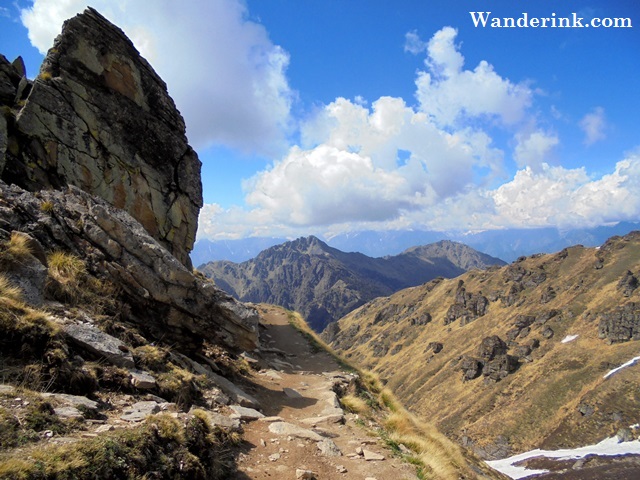
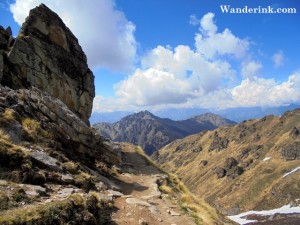
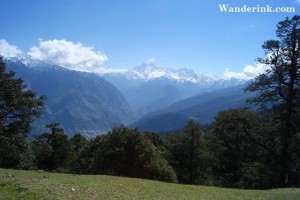
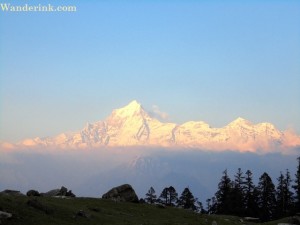
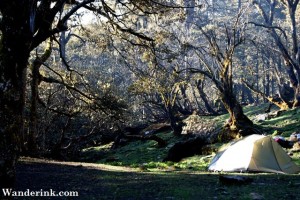
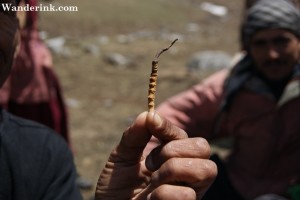
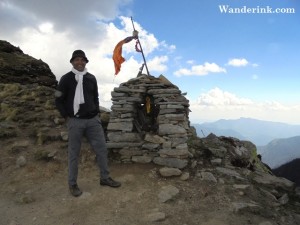
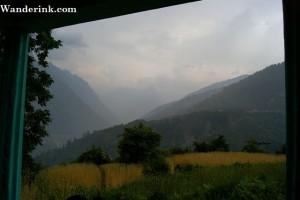









Thommen,
Although I run through so many travel blogs, I find your blog quite different. When I thought what’s so different about your blogs….I can list out few…..
Yours is not really typical travel blog written by most of people with lots of pictures….these are essentially travel guides.
There is strong influence of your stint in journalism….well written and composed lines! And yes, it resembles short guides that one reads in newspaper supplements…..a bit different from the ones in travel magazines (which are much more detailed).
I must make also mention that there is special view of your which is imprinted in your travelogue….
way to go…keep it up!!!
Thank you very much for these lovely words, Arvind… In fact I do really work on my post, like I would any other article, for I really enjoy sharing a good story/experience and if it really spurs somebody somewhere to travel, I am more than happy (trust me, it is actually pushing quite a few to take off, too!). And then again there are some publications that do accept stories from Wanderink the way they are. Will catch you sometime on some trail – again!